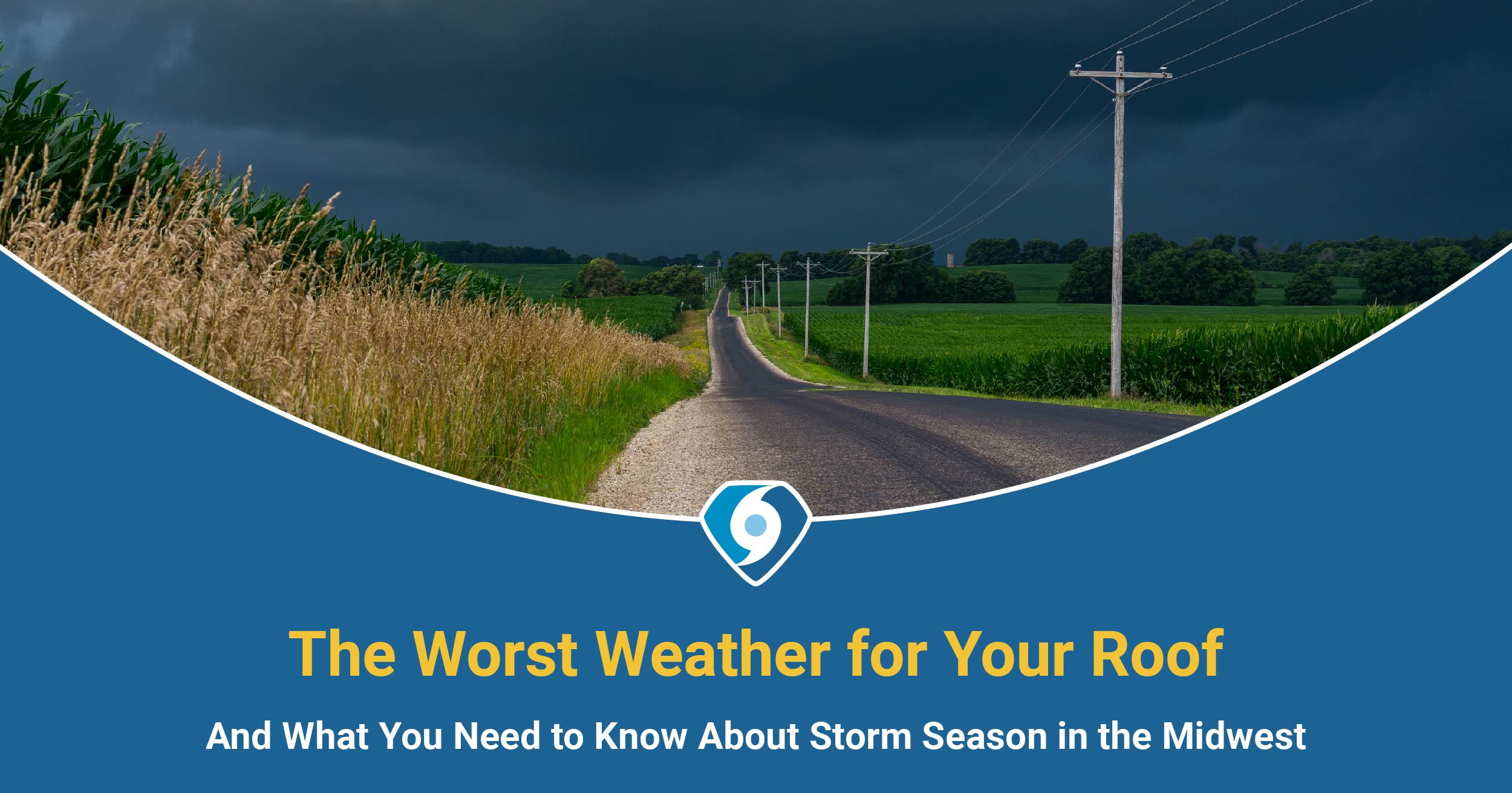
What You Need to Know About Storm Season in the Midwest
People who live in the Midwest know that weather can be unpredictable. It seems like a new storm rolls through every time the weather change, and sometimes there can even be snow and warm temperatures within the same week!
Storms are a major source of roof damage, which can lead to other detrimental effects on residential and commercial properties. Tornadoes, hailstorms, hurricanes, derechos, and tropical storms cause up to billions of dollars in damage each year, as well as fatalities. When your home's roof isn’t restored correctly, it can risk your family’s protection and security. Find out when storms in the Midwest are likely to occur and how to protect your home from storm damage.
Tornado Season in the Midwest
A tornado is one of the Midwest's most destructive and devastating types of storms. The most important thing to remember is to stay safe and seek protection. Make sure you’re aware of where you should seek shelter at home, work, or anywhere you could be when a tornado storm warning hits. Tornadoes cause the most fatalities of any storm event, while hurricanes cause the most property damage.
When is Tornado Season?
The peak tornado season for the Midwest is from May into mid-June or July. On the Gulf coast, tornado season is earlier in the spring. These destructive types of storms are likely to form during spring thunderstorms when warm, humid air collides with cold, dry air. As the warm air rises, the colder air forms around it and can cause an updraft.
Where Do Most Tornadoes Occur in the Midwest?
There is an area in the Great Plains known as Tornado Alley, where each tornado season brings a lot of activity. The states most commonly included are Texas, Oklahoma, Kansas, Missouri, Iowa, Nebraska, and South Dakota.
What Damage is Caused By Tornadoes?
The devastation left behind after a tornado depends on its intensity. Experts use the Enhanced Fujita Scale during tornado season to determine the strength of this type of storm.
- EF0 - 65 to 85 mph winds: This level only causes minor property damage. People should notice broken tree branches and potentially power lines down.
- EF1 - 86 to 110 mph winds: After this storm, you’ll notice broken windows, trees uprooted from the ground, cars and mobile homes rolled over or blown around, and even the roofs of homes torn off.
- EF2 - 111 to 135 mph winds: These strong winds can cause considerable damage. EF2 tornadoes can snap or uproot large trees, lift cars off the ground, and tear the roofs off homes.
- EF3 - 136 to 165 mph winds: Severe tornadoes leave a mess in their wake. This level of storm can tear the walls off of homes, lift heavy cars, collapse cell phone towers, and move or destroy mobile homes and structures without proper foundations.
- EF4 - 166 to 200 mph winds: The effects after an EF4 tornado are devastating. The walls will collapse on well-built houses and schools, and it can cause significant damage to high-rise buildings.
- EF5 - 200+ mph winds: The highest level of tornado damage will cause trees to be debarked with only large branches remaining, extensive destruction to high-rise buildings and schools, and houses to be completely destroyed.
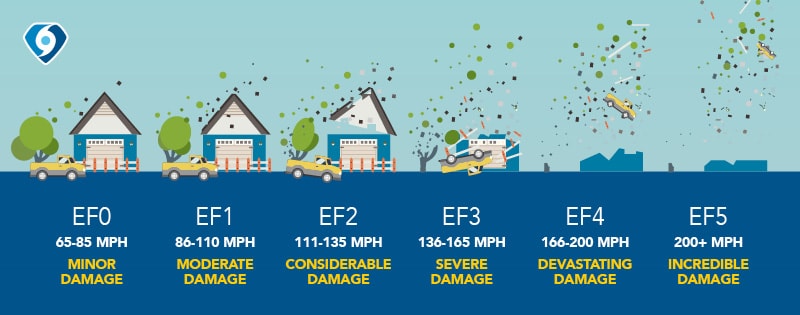
How Do Tornadoes Damage Property? Roof Damage Caused by Tornadoes
Damage from tornadoes is usually caused by high winds and flying or falling debris. This can remove or tear shingles away from a home or cause tree branches and other flying objects to damage siding, windows, or other parts of the home. Luckily, according to U.S. tornadoes, about 90% of recorded tornadoes are weak with a EF0 or EF1 rating, so the damage caused by tornadoes is usually not devastating for homeowners.
If you do experience a tornado or high winds in your area, we recommend scheduling a property evaluation or checking for the following signs of property damage caused by a tornado:
- Shingles of a home could be peeled off, curled, torn, or missing. If you’re unsure of damage, get a better look at your roof with a free drone roof inspection.
- Check for damage to gutters, chimneys, soffits, fascia, and other roof accents. Strong winds have the power to shift some of these features out of place.
- Leaks, discoloration, or peeling paint on the ceiling or walls are a giveaway that your roof has suffered damage from a storm. It’s important to take action quickly to avoid significant damage to your home.
- High winds, heavy rainfall, and more can impact even areas that aren’t directly hit by tornadoes. If there’s been a storm in the area, make sure you take the time to check for common signs of wind damage around your home.
Hail Storm Season in the Midwest
Depending on the size of the hail, hailstorms can do quite a bit of damage to a home’s roof! We’ll review when you can expect hail damage and what to look for after your area has been hit with hail.
What Time of Year Does Hail Occur?
Hail can strike anytime during thunderstorms in the spring, summer, and fall, but most storms happen from May through September. A drop in temperatures during this time is a good indicator of a potential hailstorm.
How Does Hail Form?
When warm and cold fronts meet during a storm, raindrops are carried by rising updrafts into the cold atmosphere, turning them into hailstones. The hail drops once they are large enough that its weight cannot be supported by the updraft, according to The National Severe Storms Laboratory.
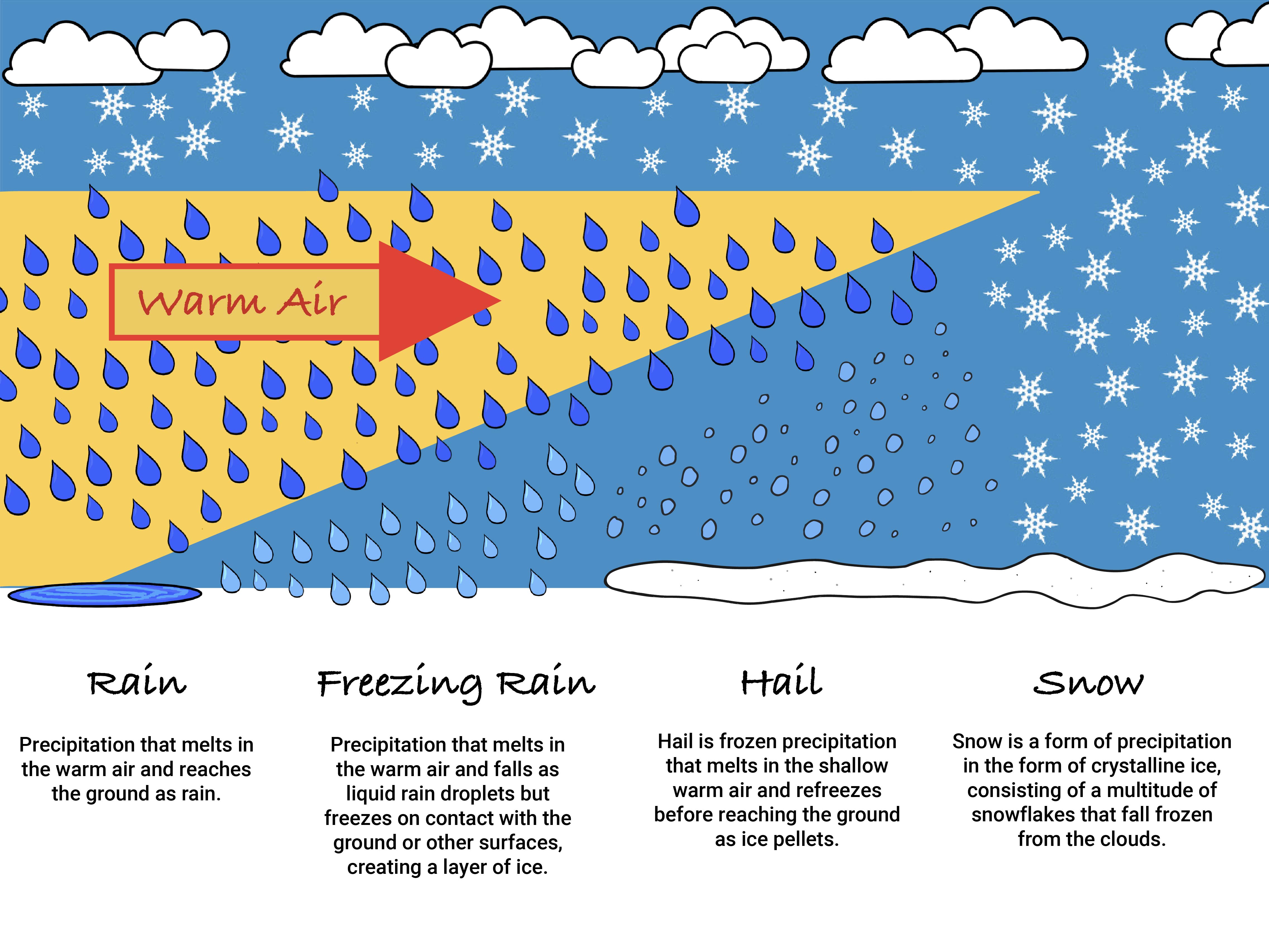
Identifying Hail Damage to Your Roof
Hail damage varies depending on the size of the hail your area has experienced, but there are common places to look for hail damage that property owners should keep in mind after a storm:
- Shingles: The first place to look for damage is your shingles. Hail can dent, crack or damage your shingles, and some may even go missing after a big hailstorm. You may also notice a lack of granules, which is part of the shingles that gives it a nice color and texture.
- Siding: Similar to shingles, this part of your home can take a beating in a hailstorm. You’ll notice cracks and dents on your siding, especially if strong winds during the storm forced the hail to strike the side of the house.
- Windows: If the hail is large enough, it can crack or shatter your home's windows. If you see this type of damage after a storm, contact a professional immediately!
- Gutters: Misplaced, dented, or damaged gutters and downspouts can be another sign you’ve had a severe storm in the area. Homeowners can also check the gutters for granule build-up that was lost from the harm to the shingles.
If you’re unsure whether or not you’ve experienced hail damage from the most recent storm, contact us for an evaluation. For more information about how much damage can be done based on the size of the hail, check out our handy hail damage chart!
Thunderstorms in the Midwest
Most other types of storms in the Midwest form alongside thunder and lightning. Commonly, the weather conditions that lead to a thunderstorm are the same elements that can lead to tornadoes and hail.
How Do Severe Thunderstorms & Lightning Develop?
A thunderstorm forms when warm moist air is forced to rise into colder parts of the atmosphere, usually from meeting a cold front head-on, and leads to updrafts and downdrafts. Lightning occurs when a significant charge develops within the storm from tiny ice particles colliding millions of times per second.
There are three stages to a thunderstorm:
- The Developing Stage: During development, warm air rises above the cooler air, creating large cumulus clouds that grow vertically with the warm updrafts.
- The Mature Stage: This is the most dangerous part of a thunderstorm and will determine the severity and type of storm it will develop into. Throughout the mature stage, updrafts and downdrafts coexist as it begins to rain, and these conditions are what can lead to tornadoes, high winds, hail, lightning, and flash flooding.
- The Dissipating Stage: Once the cold front takes over and the storm has run out of warm moisture, only downdrafts are left. This helps the storm dwindle down to light rain with weaker winds.
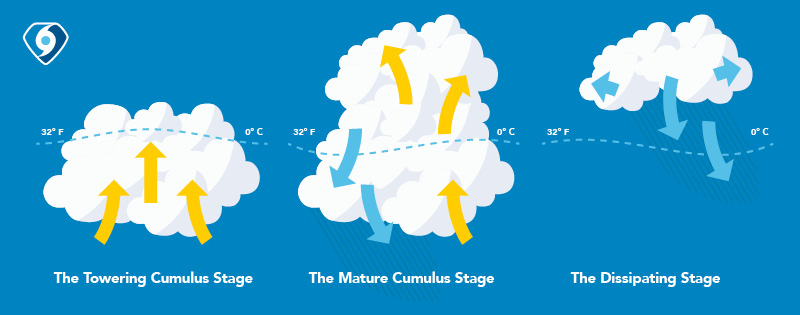
What is the Difference Between a Thunderstorm Warning and a Thunderstorm Watch?
Meteorologists will predict the severity of a storm to keep residents safe. A Severe Thunderstorm Watch means the weather conditions are favorable, and residents should prepare for a storm. A Severe Thunderstorm Warning means a threat to life and property, and those in the storm’s path should seek shelter immediately.
Can Thunderstorms Damage Homes?
Thunderstorms can lead to roof damage when accompanied by high winds or hail. Experts will look for dented, curling, or missing shingles and property damage to roof accents and siding. Contact a professional to see if your storm damage is covered by insurance.
After a storm, hire a local roofing contractor to come out for a property evaluation - they’ll be able to spot even minor signs of damage caused by any storm that has passed through. Your roofing expert can also provide insights on the urgency of repairing those damages and whether or not you should contact your insurance provider. When storms damage homes, you’ll most likely be able to file an insurance claim to compensate for specific storm damage. The drone roof inspections that Superstorm Restoration’s team performs can provide excellent images and proof of damage for homeowners submitting an insurance claim.
Snow Storms Can Lead to Roof Leaks
We can’t forget about the impact winter weather can have on a roof! Heavy snow can cause roofs to cave in when they’re not cleared off, leading to ice dams damaging your roof. Ice dams are formed when the snow starts to melt off the roof, but the water freezes to ice, blocking more excess water from running off the roof. Eventually, that water builds up and can cause roof leaks, water damage, and harm to your gutters.
Homeowners can identify the signs of an ice dam by spotting very large icicles hanging off the roof or gutters. Learn more helpful tips about how to prevent ice dams and safely get rid of excess snow on your roof!
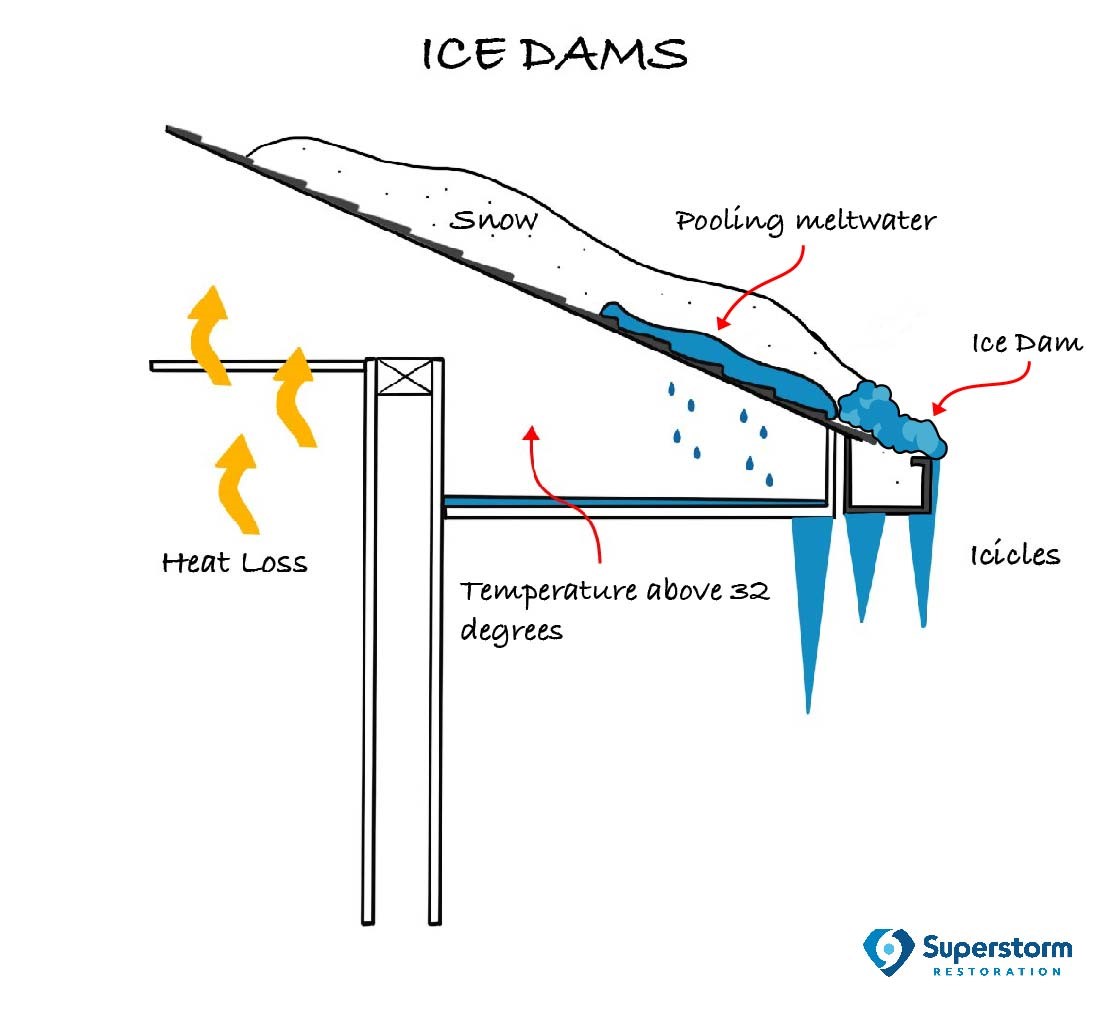
Schedule a Free Property Evaluation After Any Storm
Don't wait for the next big storm to find out if your roof is damaged. Get a comprehensive roof evaluation from experts you can trust. Contact us today to schedule an evaluation.